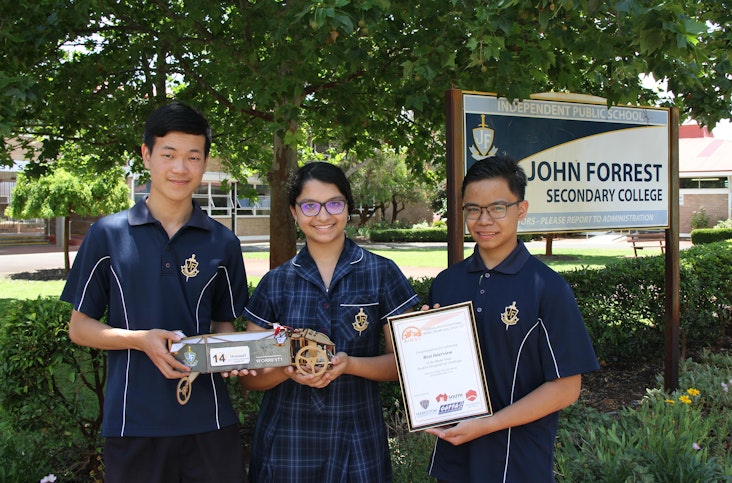SOLAR CAR CHALLENGE 2017
On 3 November 2017 five John Forrest Secondary College (JFSC) Engineering Club students, John Cuison, Rina Furnival, Christian Ho, Si Wei Lin and Joe Rechichi, with Dr Robert Woodward, entered '1Forrest1' in their first external competition, the WA Infinite Energy Solar Car Challenge held at the University of Western Australia (UWA). The challenge was to design and build an electric model car powered by a solar panel that is capable of travelling around a 100m track. Dr Woodward supervised the team who spent the course of four weeks designing and building the car for the race at UWA.
JFSC competed against 14 other teams from eight schools across WA. The first stage was a round robin competition. The team won the first race and were looking good until towards the end of the second race when one of the wheels fell off (literally). The team worked between races to repair the car and in the end won three out of their four races. This result qualified the team to compete in the finals. We were soundly beaten in the finals by 'TurboX' built by Girrawheen Senior High School a long term competitor and previous winner of the state solar car challenge. 'TurboX' went on to win the state championship and '1Forrest1' made a comeback to win the race-off for third place.
As a result of placing third at the State Championships the JFSC team received an invitation to compete in the Australian National Model Solar Car Challenge (ANMSCC) in Adelaide on 25 to 26 November. With the support of the College, Dr Woodward and the team travelled to Adelaide to compete in the National competition. The team decided to take what they had learnt at the state solar car challenge and completely redesigned and built a new car. With the competition rapidly approaching, the students worked nearly every afternoon and with the support of the Technology and Science Departments and the team managed to nearly get their car ready. The final construction was completed in Adelaide the night before the race.
A total of 24 cars competed in the ANMSCC, including two teams from Taiwan. The race was a pursuit race where cars start on opposite sides of the track and the car that completes three full loops of the track first (or catches their competition) wins.
Day one of the ANMSCC the team lost its first three races in the round robin series due to a variety of structural failures. This had the team working hard to modify their car to cope with the stresses imposed by racing. The second half of the day was more successful ending the day with three wins out of six.
Day two delivered thick clouds which meant that the solar panels were producing minimal power. Teams battled against time to re-engineer their cars to run-on minimal power ready for the race. JFSC made the elimination rounds, which were a best of three. JFSC lost the first of its eliminations due to a structural failure, but a quick fix saw the team win the next two races to progress to the round of 16.
The first race of the round of 16 '1Forrest1' had a minor structural failure and lost the first race to 'Helicos II' from Tasmania. Another quick fix and '1Forrest1' pulled ahead in the second race to take the win. 'Helicos II' made some changes before the deciding race and, although close, 'Helicos II' took the decider to win two to one. The eventual winner in a clean sweep of the grand final was 'Cheetah' built by Box Hill Senior Secondary College in Victoria.
The Australian National Model Solar Car Challenge is not just about the fastest car on the day but also about how students demonstrate their understanding of the engineering principles behind the cars and how they work. To assess this, students are required to prepare a poster and undergo an interview about their car. The JFSC team won the prize for the best interview. One of the interviewers said the team as a whole had a clear idea about the important concepts in the race and how they had designed their car to tackle these problems. The team also showed understanding that exceeded those of older students in the competition. He also mentioned that some of the concepts and designs were very novel and he hoped to see how the design progressed in future competitions.

Image - Students who travelled to Adelaide with their car and 'Best Interview Award'.






